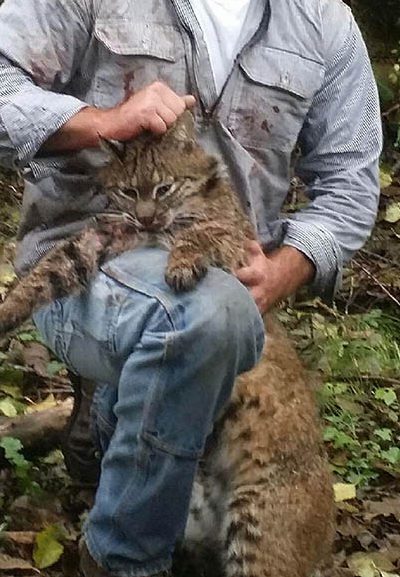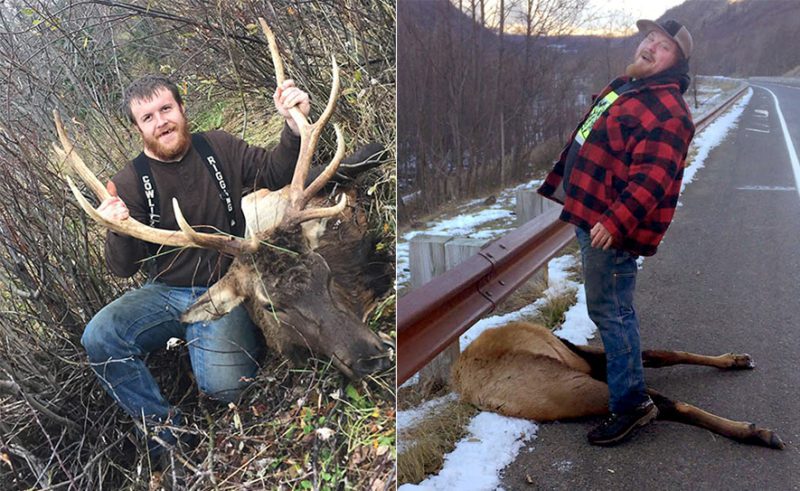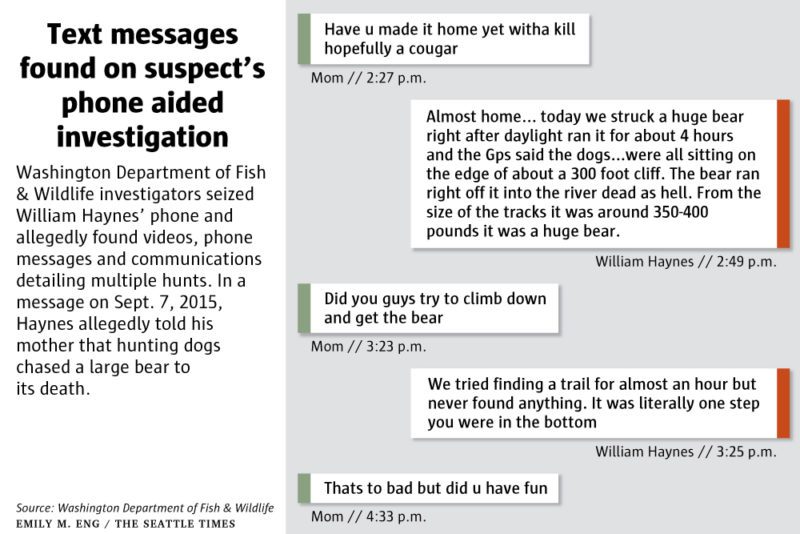According to Seattle Times, the Wasco, Ore., County District Attorney’s office charged eleven people with misdemeanor wildlife crimes in that county Tuesday. Some of those charged in Oregon are also being prosecuted in Washington state for allegedly killing bears, deer, elk or bobcats illegally. Members of the loose network often filmed or photographed their hunts, capturing gruesome scenes, including some in Washington that showed hunting dogs gnawing on dead or wounded bears. In some hunts, the alleged poachers left their prey to waste, collecting little meat or hide, investigators said.
Between the two states, at least 17 people have been implicated in the poaching investigation. At least two men have pleaded guilty to poaching-related crimes.
Officials in both states have said the case is among the largest and most complex they’ve ever investigated, but still don’t have a full understanding of the alleged poachers’ motives, other than to kill for thrill.

A photo from the WDFW case files shows a person holding up a dead bobcat. WDFW concealed the man’s face. Police say the photo was taken from Haynes’ seized phone. Officers are pursuing cases against more suspects.
“Why would somebody do this? I don’t fully understand,” said Tim Schwartz, a Fish and Wildlife lieutenant with the Oregon State Police.
“For some of these people, it was kind of a demented social club. For some, it was about ego and bravado — who could kill the biggest, the most,” said Craig Gunderson, a senior trooper who spent more than a year investigating the case in Oregon. “For some people, it’s what their family did.”
The case began in November 2016, when Oregon State Patrol officers installed game cameras on national forest land near The Dalles.
“Nearly every year, it seems we have deer showing up minus their heads at the end of seasons,” Gunderson said. They hoped to catch someone in the act.
Just three days after troopers set them up, the motion-triggered cameras captured images of people in a truck shining a spotlight into the woods, then exiting the vehicle with rifles and head lamps, according to investigative reports. The Oregon troopers later found a headless deer near the location where the truck had been photographed.
A few days later, the troopers recognized the truck and pulled it over, Gunderson said.
Cellphones seized from the suspects, which contained photos and videos of hunts as well as text messages, ultimately led Washington officers to more than 20 kill sites in Southwest Washington and several more suspects. Eight people were initially charged last fall in Skamania County with more than 190 counts of wildlife violations, including 33 felonies. Since then, more charges have been filed in other Washington counties.
Meantime, Oregon officials continued to work the case, visiting several kill sites there and compiling digital evidence. In January, officials charged nine people with wildlife crimes in Clatsop County, three of them with additional violations in Lincoln County and four of them with additional violations in Clackamas County. But most of the Oregon violations — some 120 misdemeanors in all — allegedly occurred in Wasco County.
Officials there charged William Jarred Haynes, 24, with 45 counts; Erik Christian Martin, 24, with 42 counts; Joseph Allen Dills, 31, with 12 counts; Aaron Brian Hendricks, 35, with five counts; David R. McLeskey, 59, with four counts; Sierra Dills, 18, with four counts; Eddy Alvin Dills, 58, with two counts; Kimberly Kathrin Crape, 20, with two counts; Wyatt Keith, 17, with two counts; Aubri Nicole McKenna, 36, with one count; and Aaron Colby Hanson, 38, with one count.
Charges included unlawful taking or possession of wildlife (including deer, bear, bobcat, squirrel and cougar); waste of wildlife; hunting with an artificial light; use of dogs or bait to hunt (cougar and bear); criminal conspiracy; aiding or sharing in a wildlife violation; and altering, borrowing or loaning a license, tag or permit.
Gunderson said troopers have evidence they believe proves seven bobcats, four cougars, five bear, 35 deer and one silver gray squirrel were killed by the group in Oregon alone. Most of the animals were left to waste.
“The scope of what we can prove and what actually happened, there’s a real gap there,” Gunderson said. “We’ll never have the whole story, but the stuff we can prove is pretty gross.”
He said members of the group communicated about their plans and some members went on outings as often as weekly looking to kill.
“They all knew what they were doing was illegal. They all thought it out ahead of time and had plans. Some of them had been doing it for years,” Gunderson said.
Unlike Washington, where spree killing is a felony, Oregon’s wildlife violations are misdemeanors.

Suspect William Haynes (left) poses with a dead elk. On right: Joseph Dills stands over a dead elk that police allege was killed by his girlfriend, Aubri McKenna. (Washington Department of Fish & Wildlife)
Schwartz and Gunderson both said they would like to see Oregon’s Legislature look at creating a felony statute for those who kill multiple animals in quick succession.
As investigators continue to pore over evidence, more charges could be coming in Washington.
Poaching — unlawfully taking fish or game — can describe a number of crimes: Not having a proper license to hunt, hunting out of season or hunting in restricted areas.
Using dogs on recreational big-game hunts is also illegal, as is leaving carcasses to rot.
In this case, bears and bobcats were allegedly cornered by hunting hounds before being shot and left to waste.
Evidence collected by police shows much of the hunting was done in broad daylight in the Gifford Pinchot National Forest in Southwest Washington. But investigators say they might’ve missed it if not for images caught after nightfall by a motion-sensitive camera.
Officers never received a tip about the suspects. They believe the suspects used lookouts and radios to avoid detection. Officers wonder if a culture of selfie sticks and social media fueled them.
“Nowadays, with social media, people want likes on Instagram and Facebook and bragging rights with buddies,” said Officer Tyler Bahrenburg, who helped work the case.
If it did not motivate, that impulse to share certainly helped unravel the conspiracy.
Over nearly nine months, investigators stitched together hundreds of text messages, videos, photographs and social-media posts to develop this case.
One suspect, William J. Haynes, allegedly texted his mother a selfie of himself covered in splatters of a bear’s blood. “We were a little close when they shot it haha,” he wrote.
“Our investigation is still ongoing,” said Washington Department of Fish and Wildlife Sergeant Brad Rhoden. “There are still matters that we’re looking into. By no means are we done with our field work.”
Gunderson said he hopes the attention received by this case prompts people to report suspicious encounters in the woods. “These guys aren’t unique. There are a lot more people attempting this stuff,” he said.



